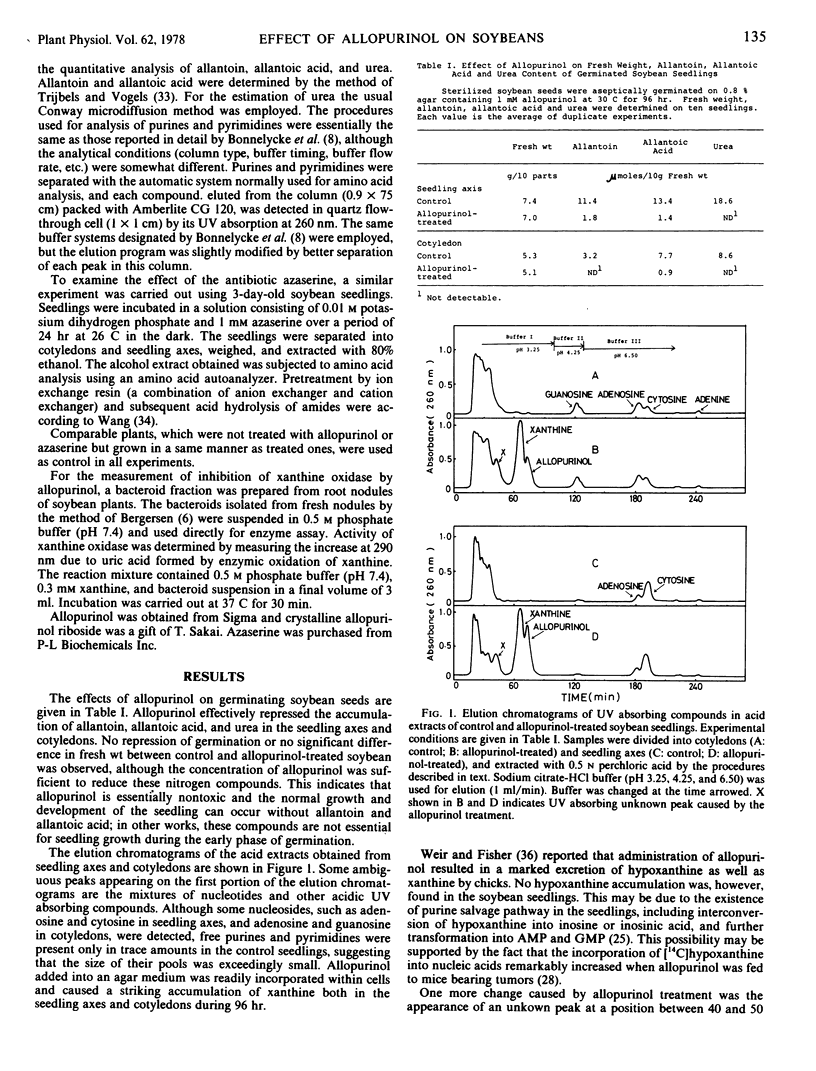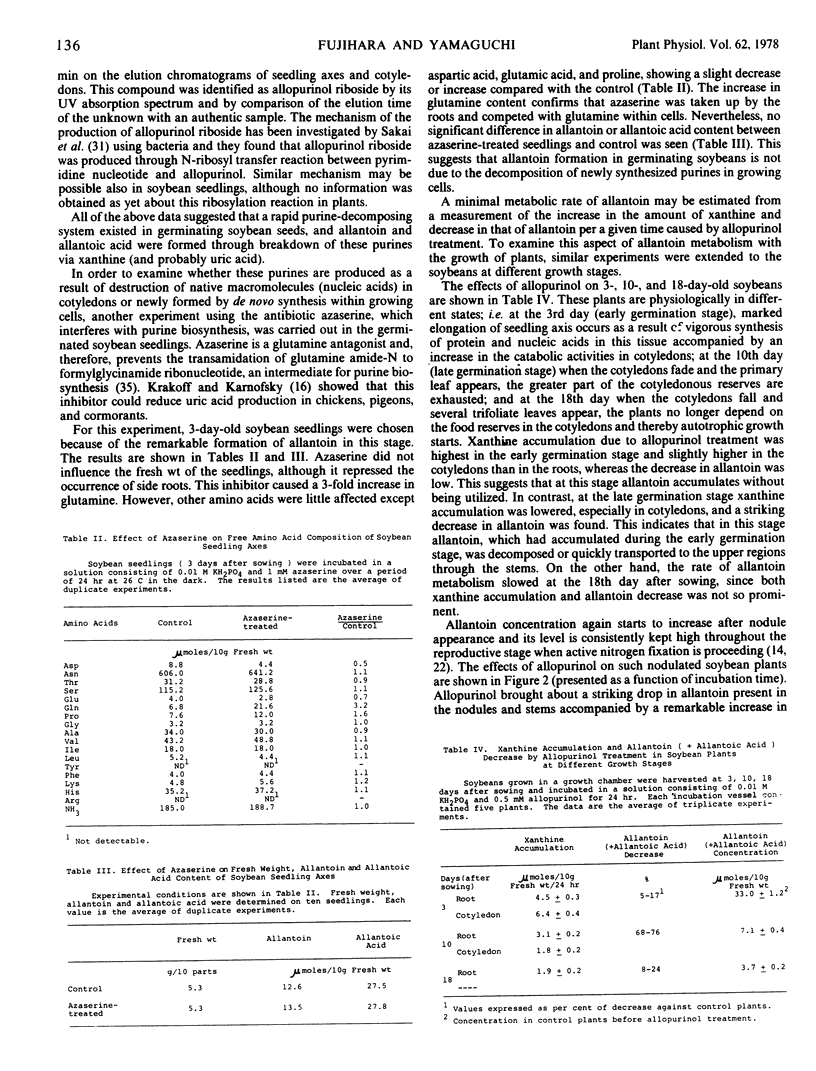Abstract
Some studies on the effects of xanthine oxidase inhibitor allopurinol [4-hydroxypyrazolo(3,4-d)pyrimidine] on allantoin metabolism of soybean plants (Glycine max cv. Tamanishiki) are reported. Soybean seedlings, aseptically germinated for 96 hours on agar containing 1 millimolar allopurinol, contained only slight amounts of allantoin, allantoic acid, and urea as compared with controls. Analysis of purines and pyrimidines of the allopurinol-treated seedlings showed marked accumulation of xanthine both in the cotyledons and seedling axes. No hypoxanthine accumulation was found. Xanthine accumulation due to allopurinol treatment was relatively low after the cotyledons had fallen. For nodulated plants, allopurinol caused a significant drop in allantoin (+allantoic acid) in the stems and nodules, accompanied by a striking accumulation of xanthine in the nodules. The xanthine concentration in the nodules far exceeded that in the germinated seedlings. Allopurinol at a concentration of 50 micromolar strongly inhibited xanthine oxidase prepared from soybean nodules.
The results suggested that the main pathway of allantoin formation in soybean plants was through purine decomposition, via xanthine-uric acid. It was specially noted that a very active purine-decomposing system existed in soybean nodules.
Full text
PDF




Selected References
These references are in PubMed. This may not be the complete list of references from this article.
- AMMANN E. C., LYNCH V. H. PURINE METABOLISM BY UNICELLULAR ALGAE. II. ADENINE, HYPOXANTHINE, AND XANTHINE DEGRADATION BY CHORELLA PYRENOIDOSA. Biochim Biophys Acta. 1964 Jul 22;87:370–379. doi: 10.1016/0926-6550(64)90110-0. [DOI] [PubMed] [Google Scholar]
- BACHRACH U. The aerobic breakdown of uric acid by certain pseudomonads. J Gen Microbiol. 1957 Aug;17(1):1–11. doi: 10.1099/00221287-17-1-1. [DOI] [PubMed] [Google Scholar]
- BERGERSEN F. J. The bacterial component of soybean root nodules; changes in respiratory activity, cell dry weight and nucleic acid content with increasing nodule age. J Gen Microbiol. 1958 Oct;19(2):312–323. doi: 10.1099/00221287-19-2-312. [DOI] [PubMed] [Google Scholar]
- Bongaerts G. P., Vogels G. D. Uric acid degradation by Bacillus fastidiosus strains. J Bacteriol. 1976 Feb;125(2):689–697. doi: 10.1128/jb.125.2.689-697.1976. [DOI] [PMC free article] [PubMed] [Google Scholar]
- Bonnelycke B. E., Dus K., Miller S. L. Simultaneous analysis of purines, pyrimidines, and amino acids. Anal Biochem. 1969 Feb;27(2):262–272. doi: 10.1016/0003-2697(69)90031-1. [DOI] [PubMed] [Google Scholar]
- Ingle J., Hageman R. H. Metabolic changes associated with the germination of corn. II. Nucleic acid metabolism. Plant Physiol. 1965 Jan;40(1):48–53. doi: 10.1104/pp.40.1.48. [DOI] [PMC free article] [PubMed] [Google Scholar]
- KRAKOFF I. H., KARNOFSKY D. A. Inhibition of uric acid biosynthesis in birds by o-diazoacetyl-L-serine (azaserine) and 6-diazo-5-oxo-L-norleucine (DON). Am J Physiol. 1958 Oct;195(1):244–250. doi: 10.1152/ajplegacy.1958.195.1.244. [DOI] [PubMed] [Google Scholar]
- LEDOUX L., GALAND P., HUART R. Nucleic acids and protein metabolism in barley seedlings. II. Interrelations of the different organs. Exp Cell Res. 1962 Jun;27:132–136. doi: 10.1016/0014-4827(62)90050-2. [DOI] [PubMed] [Google Scholar]
- LEDOUX L., HUART R. Nucleic acids and protein metabolism in barley seedlings. IV. Translocation of ribonucleic acids. Biochim Biophys Acta. 1962 Aug 20;61:185–196. doi: 10.1016/0926-6550(62)90081-6. [DOI] [PubMed] [Google Scholar]
- Murray A. W. The biological significance of purine salvage. Annu Rev Biochem. 1971;40:811–826. doi: 10.1146/annurev.bi.40.070171.004115. [DOI] [PubMed] [Google Scholar]
- OKI Y. Pathophysiological effects of circulating ferritin. Nature. 1959 Dec 19;184(Suppl 25):1944–1945. doi: 10.1038/1841944b0. [DOI] [PubMed] [Google Scholar]
- POMALES R., BIEBER S., FRIEDMAN R., HITCHINGS G. H. Augmentation of the incorporation of hypoxanthine into nucleic acids by the administration of an inhibitor of xanthine oxidase. Biochim Biophys Acta. 1963 May 28;72:119–120. [PubMed] [Google Scholar]
- ROUSH A. H., SHIEH T. R. Diffusion, active transport and metabolism of purines in the yeast Torulopsis candida. Biochim Biophys Acta. 1962 Aug 20;61:255–264. doi: 10.1016/0926-6550(62)90088-9. [DOI] [PubMed] [Google Scholar]
- Trijbels F., Vogels G. D. Degradation of allantoin by Pseudomonas acidovorans. Biochim Biophys Acta. 1966 Feb 14;113(2):292–301. doi: 10.1016/s0926-6593(66)80068-1. [DOI] [PubMed] [Google Scholar]
- Weir E., Fisher J. R. The effect of allopurinol on the excretion of oxypurines by the chick. Biochim Biophys Acta. 1970 Nov 24;222(2):556–557. doi: 10.1016/0304-4165(70)90155-8. [DOI] [PubMed] [Google Scholar]


